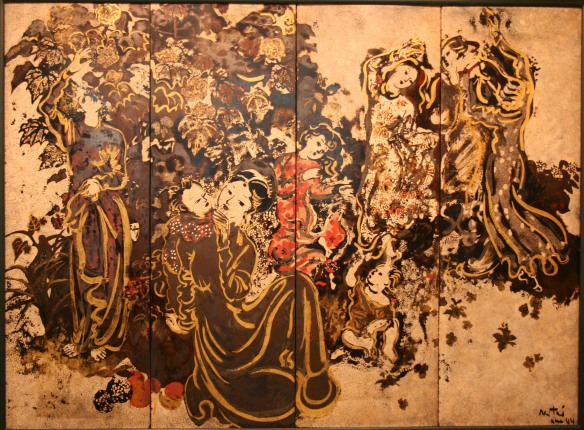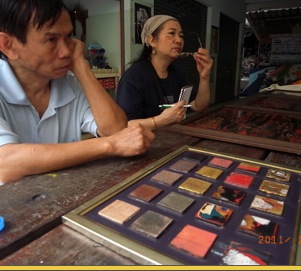The school of Fine Arts of Indochina: 1st group of Student (part3)
Posted: 2011/05/09 Filed under: Art, Artist, Asia, France, Lacquer, Lacquer Painting, Modern Art, Nguyen Gia Tri, Research, Southeast Asian, THE ECOLE DES BEAUX-ARTS IN HANOI, tradition, Urushi, Vietnam, Western Leave a comment
Indocina Fine Arts College (Ecole Superieure des Beaux-Arts de), 1929 . Source: The Fine Arts Publishers
1st generation students of THE ECOLE DES BEAUX-ARTS IN HANOI
May Trung Thu,(1890-1973)
A graduate of the school of fine arts of Indochina in 1930 (first promotion), he became Professor of drawing at Huế where he likes to attend the musicians of this city. In 1937 that he arrived in France at the international exhibition where his works are presented and decided to settle there.
While participating in the Salon des Indépendants and fall, it became known by playing doc-huyen, monotonous instrument. He participates regularly in concerts of traditional music, in the company of the famous musicologist Tran Van Khe.
Committed voluntary in 1940, the armistice he remains blocked some time to Mâcon where it performs a setting for one of the chapels of the Saint-Pierre church.
In 1942, he was invited by Algeria. Back in Paris, apart from a few film on Vietnam, he devoted himself to his painting.
Character independent, discrete, this full artist quickly used silk as pictorial support, according to a technique he developed to the point of successive washes to soften the tones. His favourite themes are children and young girls that it depicts intimate way.
In an idealized vision its women are Gracile, elongated, pensives or nostalgic. The culvert is light in the edges, subtle, controlled compositions in which nature is merely incidental.
May Thu is a verbose painter, influenced by the aesthetic japonisante, it pushes the refinement up to conduct himself coaching of his works, he adorns scrolls in gold leaf.
Lê Phô (1947 1907) 
Born in Ha Tay province into a family of senior mandarins (his father is the viceroy of Tonkin), he joined the school of fine arts of Indochina from its inception (promotion 1925-1930).
The colonial exhibition of 1931 of Vincennes where his works are presented and where he attended Victor tardieu, Member of the Board of the craft section of the exhibition. He stayed in France and follows a year of courses at the Ecole des beaux-arts in Paris. Then he traveled to Belgium, Holland, Italy where he discovered the "primitives" that will greatly influence its opens.
In 1933, he returned to Vietnam and he teaches at the Ecole des beaux-arts in Hanoi while achieving official orders for the Palace of Hué.
It was in 1937, while he is the Director artistic Division of Indochina in the international exhibition, that he decided to settle in France. In 1941, with the painter may Thu, he is invited to exhibit in Algeria.
It is one of the most renowned Vietnamese painters. While both working painting technique to oil and silk, he seems to have, over the years, rather preferred the first.
Through its preferential themes, women and flowers, can be distinguished an interesting stylistic evolution:
- – the classical period, which corresponds to the Vietnamese years where a solid brush, insured, it creates and works inspired by its close environment as evidenced "the wife of the mandarin" or "home of the Tonkin".
- – the primitive period, determined by his trip to Italy. It adopts a more idealistic vision, faces to refine, the stroke is lighter, the shimmering palette is worked in stillness on silk.
- – the last period is, through exclusively technique in oil, light, with the use of a particularly sustained yellow, that he worked in the Impressionist manner, by removed keys and bright, the brush stopping at more length on the faces.
Nguyen Gia Tri (1908-1993)
(Originally from the province of Ha Tay, it incorporates the school of fine arts of Indochina in 1929 fifth promotion) but interrupted his education. Prompted by Victor Tardieu to resume it, it is then among students in the seventh promotion which he eventually graduated.
In 1946, he left Hanoi for Hong Kong where it preferentially uses the technique of oil painting. It remains there until 1951.
In 1954, he left living in Saigon, leading a studious, withdrawn, fully vested existence to painting.
He knew wear at its peak the art of lacquer, seduced by the possibilities of this matter so subtle and Eastern decorative and pictorial. Sanded lacquer technique was for him a quasi-révélation.
Nguyen Gia Tri realized between 1939 and 1945 a very large number of works in panels, screens, doors of Cabinet. To do this, he used in his Studio to surround themselves with a team of artisans lacquerers.
Its vibrant, valuable, while pace style is a kind of allegorical dream vision in which young women air and dancing move.
From 1966, he begins to run, lacquer, paintings of abstract invoice, which he had long desire.
Artist to right and gentle temperament, he has truly revolutionized this material, applying overlays to the shell of egg, using extensively the rich colours (gold, red, yellow) while knowing the oil by the affixing of shaded areas where sometimes appear a few touches of Prussian blue household.
In an interview of September 1979 (with Nguyen Xuan Viet) artist insists on the need to respect the material, to ensure that it follows the idea while using so that each detail reflects light.Real magician of lacquer, that opens more results that any other of a fit perfect and absolute osmosis between the artist and the material.
read more all in artical
- part 1 : Paris – Hanoi – Saigon: adventure of modern art in Vietnam
- part 2 : French teachers of The school of Fine Arts of Indochina
- part3: 1st Generation of The school of Fine Arts of Indochina
- part4: War Time
- part5: Renewel Time
- Artist: Master Nguyen Gia Tri (1)
- Artist: Nguyen Gia Tri (Vietnam 1908-1993)(2)
- Artist: NGUYEN GIA TRI (note from Artfact.com)(3)
Source: http://asiep.free.fr/printempsvietnam/par-han-sai.html
translate by microsofttranslator.com


